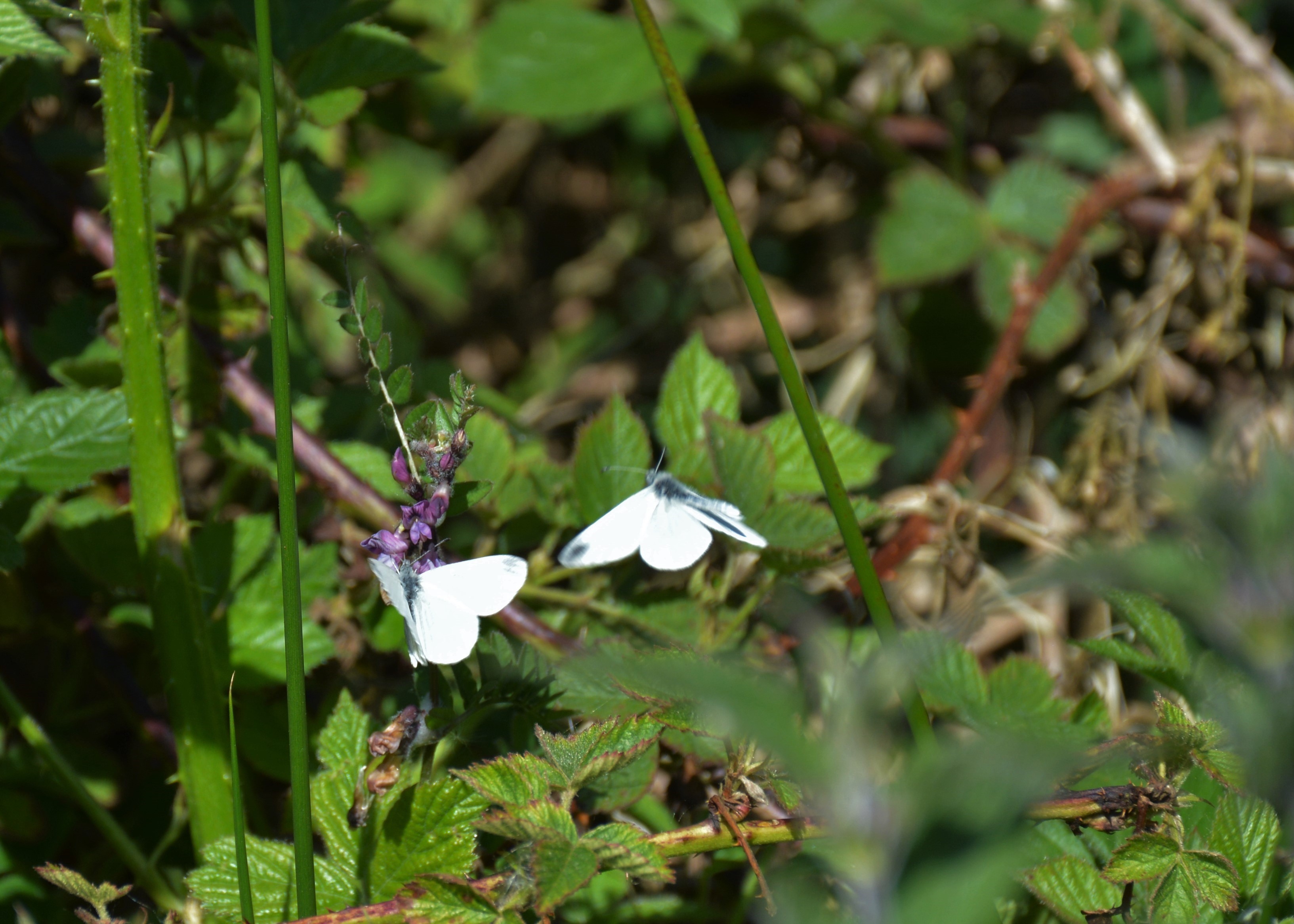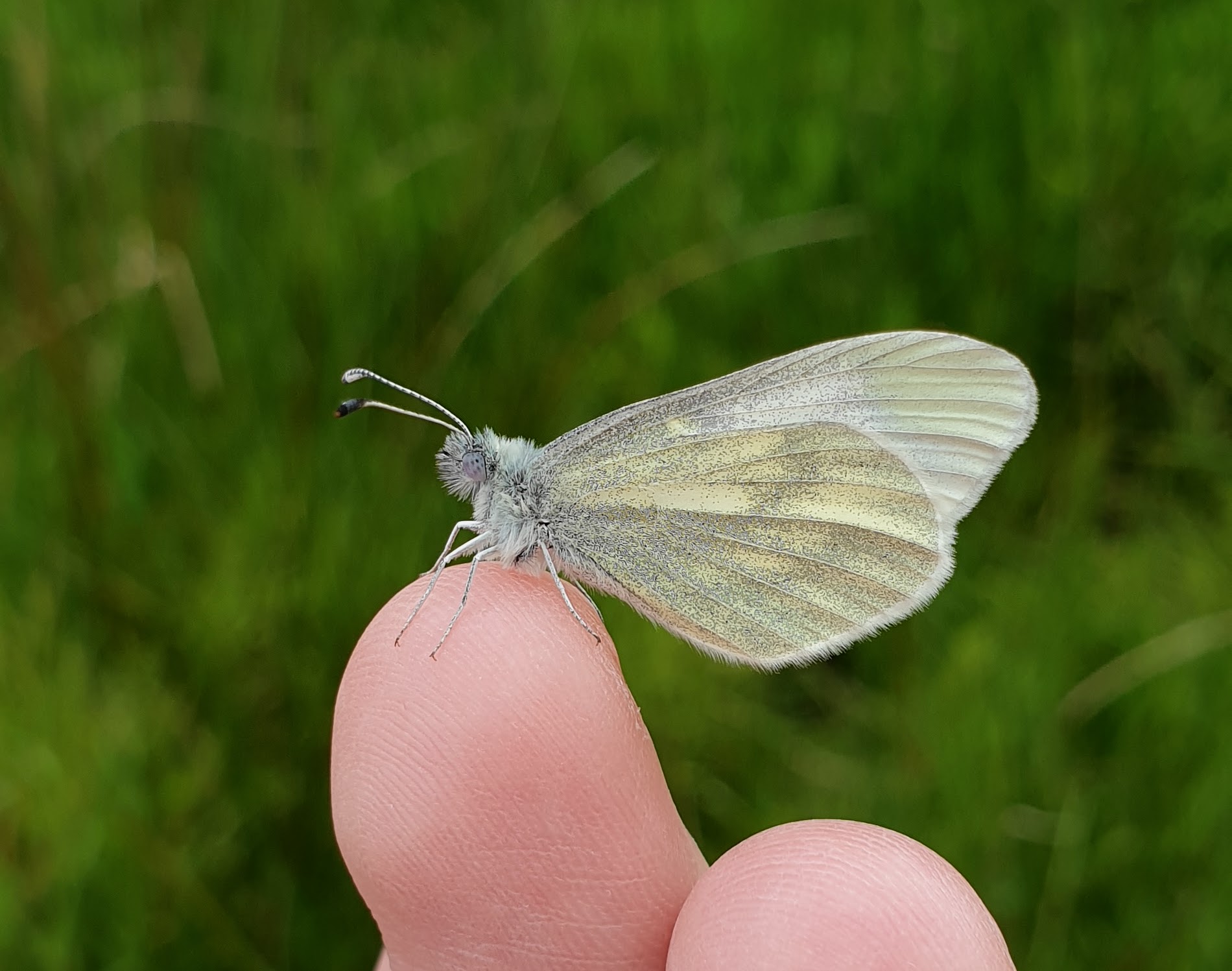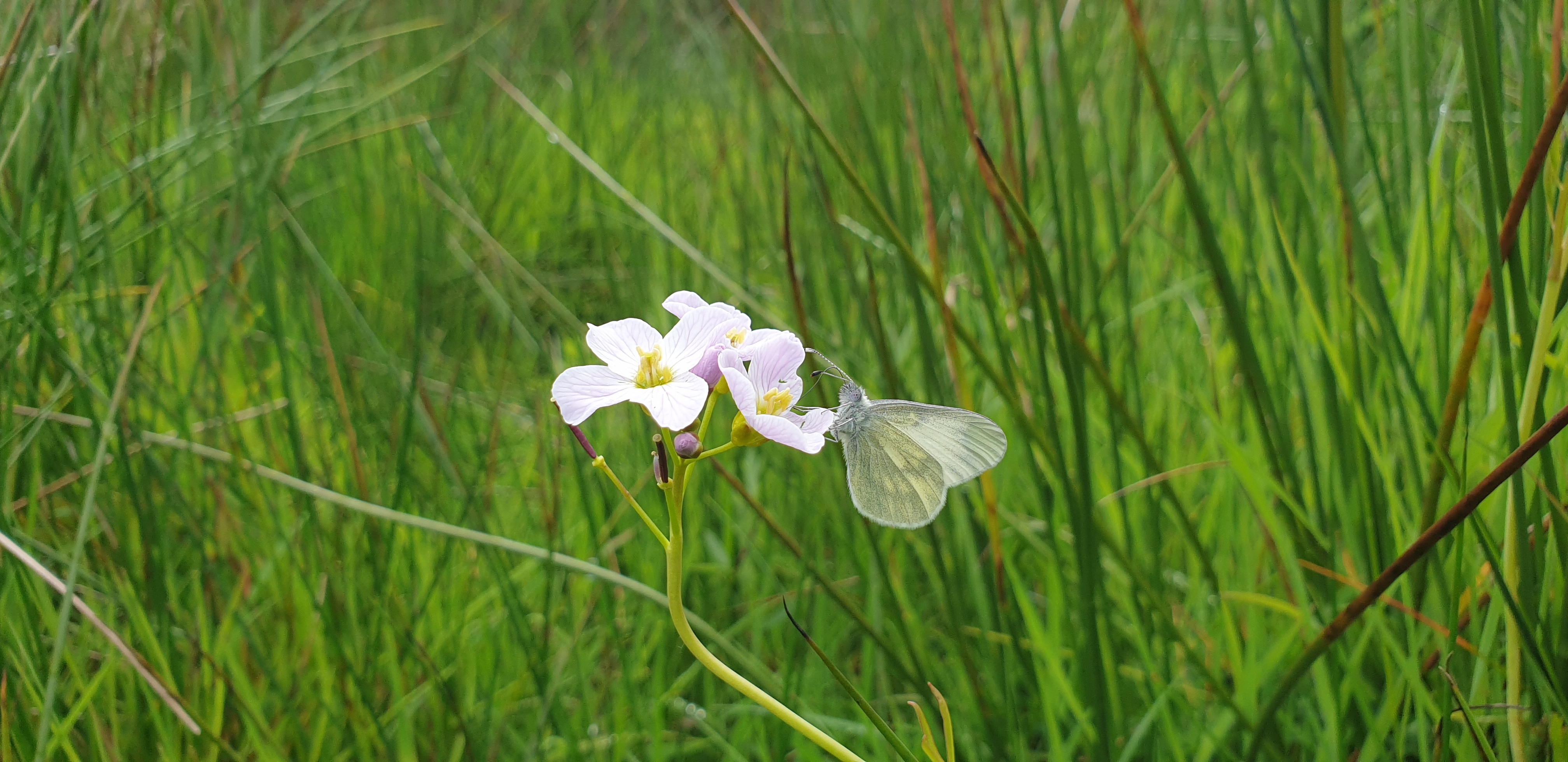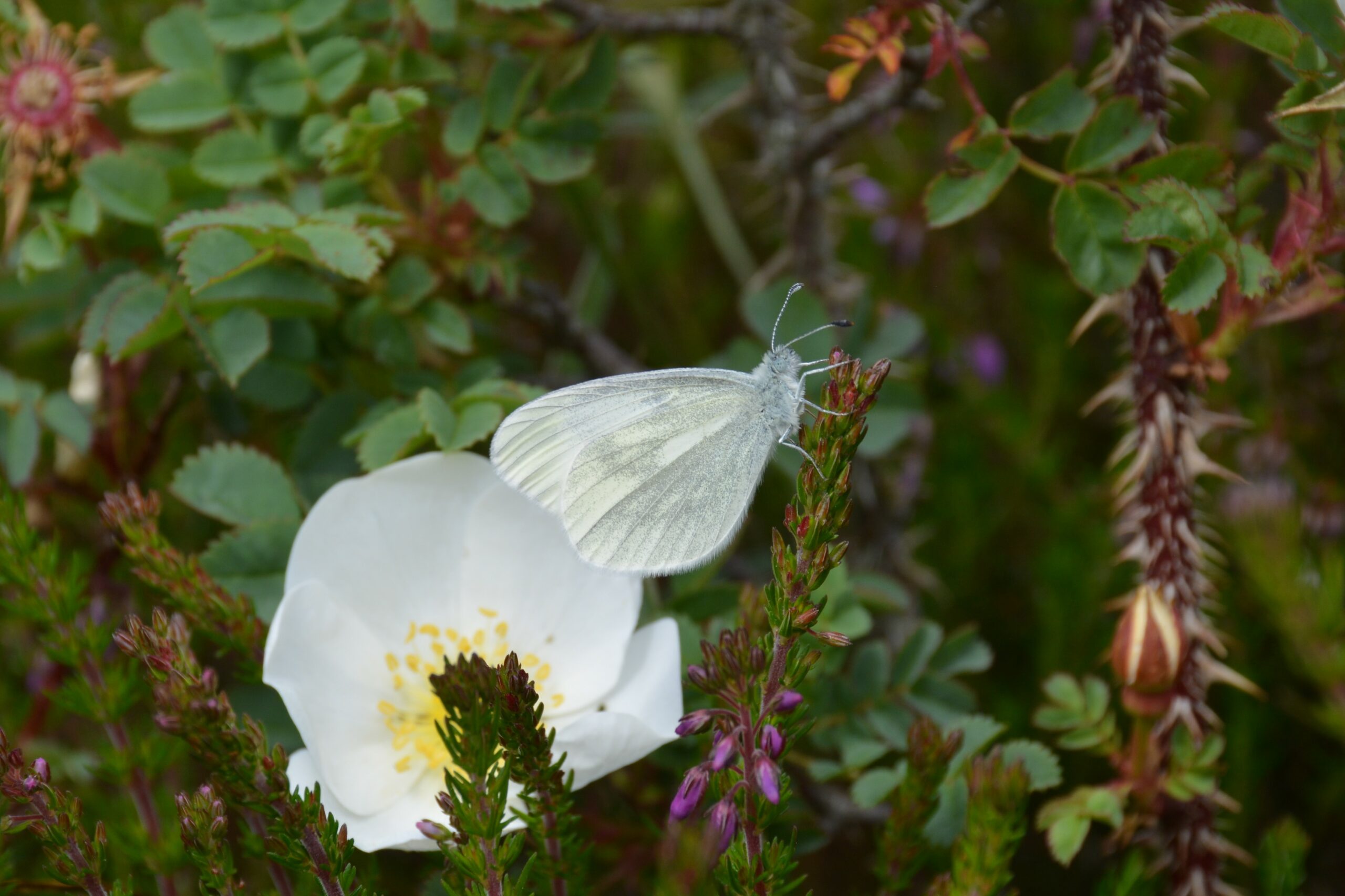My favourite butterfly, which I first saw during lockdown. They are the most delicate of the white species (Pieridae) found in Ireland and flutter through grasslands in May and June.

Taxonomy
For a long time, scientists wondered why Wood Whites (Leptidea sinapis) were fairly widespread and common in Ireland, when they were so rare in England. Then, first in the 80s and then in 2011, it was realised that there were two more “cryptic species” hidden within the Wood White¹. Réal’s Wood White (Leptidea reali) was the first to be discovered and said to be found throughout Ireland (except for the Burren, where L. sinapis is found). However, when it was further split in two in 2011, our species was named the Cryptic Wood White (Leptidea juvernica)². It’s a great demonstration that insect taxonomy is challenging and that there is a lot of hidden biodiversity yet to be discovered.

Ecology
Cryptic Wood Whites can be difficult to see during the flight period in May and June, but at the right site they can be common. The best site I have found for them was Lagan Meadows, in a patchy mosaic of damp species-rich grassland and bramble scrub. Here the foodplants (vetches) are common in young, developing scrub and in long grass. I have also seen them at Murlough NNR on mature dune grassland. The species can exist on very small and fragmented sites: the site at Lagan Meadows is small (around 5 ha)³; I believe our field was colonised from a hedgerow/road verge population with little-to-no species-rich grassland nearby.

Foodplants
Warnock⁴ studied the species’ preferences in Armagh and found they mostly prefer to lay their eggs on Meadow Vetchling (Lathyrus pratensis), also using Lesser Bird’s-foot Trefoil (Lotus corniculatus), Greater Bird’s-foot Trefoil (Lotus pedunculatus), and rarely Bush Vetch (Vicia sepium). At Murlough they mostly use Lesser Bird’s-foot Trefoil⁴. in Edenderry, O’Neill and Montgomery³ only saw egg-laying on Meadow Vetchling.
In the same study⁴ nectar plants included Bush Vetch, Meadow Vetchling, Lesser Bird’s-foot Trefoil, Tufted Vetch (Vicia cracca), Ragged Robin (Lychnis flos-cuculi), and Red Clover (Trifolium pratense). At Murlough they have been observed using Tormentil (Potentilla erecta).
Courtship
Courtship generally occurs on the nectar plant. I have observed two courtship displays on Bush Vetch, and one on grass. The male hovers behind and above the female, then lands facing her and begins to wave his proboscis on either side of her, while she occasionally flaps her wings. If she approves of the male, mating follows, but I have never seen this and it seems to be rare⁴ – most males are rejected.
This fairly complex ritual has evolved as a response to the similarity of the different Leptidea species – the female has to spend a long time working out if the male is actually the same species as her⁵. Why do they stay separate species at all then? Well, the different species occupy different niches in the areas where their ranges overlap. It is advantageous for them to make sure they mate with those of the same species, as the offspring will then share the specialisation to that niche⁶. Hybrid offspring would be less well-adapted to either of the niches of its parents; this is a form of outbreeding depression.
Conservation
Heal⁷ reported that the Cryptic Wood White spread rapidly northwards into north-east Ulster along the railways in the mid-20th century. It is now in retreat⁴,⁸; the main concern is habitat loss⁹. At Lagan Meadows the habitat is quickly becoming inappropriate as grazing has stopped – this will stop the disturbance needed to create new areas of young scrub, and lead to the loss of the species-rich grassland.

References
N.B. I have changed the format to superscript numbers Vancouver style as I think it is less intrusive!
- Dincǎ, V., Lukhtanov, V. A., Talavera, G., & Vila, R. (2011). Unexpected layers of cryptic diversity in wood white Leptidea butterflies. Nature Communications, 2(1). https://doi.org/10.1038/ncomms1329
- Cryptic Wood White. [online] UK Butterflies. https://www.ukbutterflies.co.uk/species.php?species=juvernica [accessed 31 Dec 2022]
- O’Neill, J., & Montgomery, I. (2018). Demographics and spatial ecology in a population of cryptic wood white butterfly Leptidea juvernica in Northern Ireland. Journal of Insect Conservation, 22(3–4), 499–510. https://doi.org/10.1007/S10841-018-0077-5
- Warnock, N. (2008). The ecology and conservation of Leptidea reali (Real’s Wood White) in Northern Ireland. MSc Thesis, Queen’s University Belfast. http://ns340113.ip-5-196-79.eu:7080/images/3_programmes/papillons/biblio/43.pdf
- Friberg, M., Vongvanich, N., Borg-Karlson, A. K., Kemp, D. J., Merilaita, S., & Wiklund, C. (2008). Female mate choice determines reproductive isolation between sympatric butterflies. Behavioral Ecology and Sociobiology, 62(6), 873–886. https://doi.org/10.1007/S00265-007-0511-2
- Friberg, M., Leimar, O., & Wiklund, C. (2013). Heterospecific courtship, minority effects and niche separation between cryptic butterfly species. Journal of Evolutionary Biology, 26(5), 971–979. https://doi.org/10.1111/JEB.12106
- Heal, H. (1965). The Wood White, Leptidea sinapis L., and the Railways. The Irish Naturalists’ Journal, 15(1), 8–13. https://www.jstor.org/stable/25536916
- Staats, W. T., & Regan, E. C. (2014). Initial population trends from a 5-year butterfly monitoring scheme. Journal of Insect Conservation, 18(3), 365–371. https://doi.org/10.1007/S10841-014-9644-6
- Leptidea juvernica – cryptic wood white. [online] Northern Ireland Priority Species. http://www.habitas.org.uk/priority/species.asp?item=430857 [accessed 31 Dec 2022]

Leave a Reply